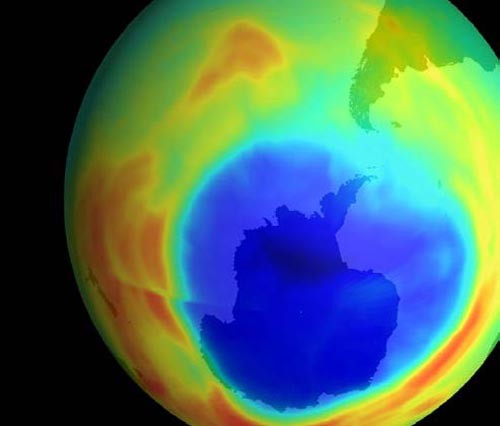Twenty years since the discovery of the Ozone Hole
by British Antarctic Survey on 25 Feb 2010

The Ozone Hole was discovered by BAS scientists - Image: NASA British Antarctic Survey
http://www.antarctica.ac.uk
It’s over twenty years since the discovery of the ozone hole drew world attention to the impact of human activity on the global environment.
Why is the ozone layer important?
The ozone layer is the Earth’s natural sunscreen that protects humans, plants and animals by filtering out harmful UV-B radiation.
In the 1970s concern about the effect of man-made chemicals, especially chlorofluorocarbons, on the ozone layer were raised by Paul Crutzen, Mario Molina and Sherwood Rowland. Their pioneering work was recognised in 1995 by the award of the Nobel Prize in Chemistry.
How was the ozone hole discovered?
Scientists from British Antarctic Survey began monitoring ozone during the International Geophysical Year of 1957–58. In 1985 scientists discovered that since the mid 1970s ozone values over Halley and Faraday research stations had been steadily dropping when the sun reappeared each spring. Something in the stratosphere (about 20km above Earth) was destroying ozone.
So what was wrong with the ozone layer?
We now know that during the polar winter, clouds form in the Antarctic ozone layer and chemical reactions on the clouds activate ozone destroying substances. When sunlight returns in the spring, these substances (mostly chlorine and bromine from compounds such as chlorofluorocarbons and halons) take part in efficient catalytic reactions that destroy ozone at around 1% per day. This discovery changed the world.
What happened after the hole was discovered?
NASA scientists used their satellite data to confirm that not only was the hole over British research stations but it covered the entire Antarctic continent. International efforts by scientists and politicians then led to steps to control the production and use of CFCs and other ozone depleting chemicals. The resulting Montreal Protocol (1987) and its subsequent amendments is a successful example of world leadership in tackling a global environmental issue.
How successful is the Montreal Protocol?
The Protocol is having a clear effect and the amount of ozone destroying substances in the atmosphere is beginning to go down. Nevertheless, the original compounds are so stable and long-lived that an ozone hole will exist each Antarctic spring for at least another 50 years.
Is there a hole over the Arctic?
Unlike Antarctica, which is a continent surrounded by oceans, the Arctic is an ocean surrounded by mountainous continents. This means that the stratospheric circulation is much more irregular. Because it is not as cold as the Antarctic, stratospheric clouds are less common. So a deep ozone hole over the North Pole is unlikely, but limited ozone depletion can occur above parts of the Arctic, though it lasts only a few days at a time.
And what about elsewhere?
In 1996 stratospheric clouds were seen widely over the UK and a small, short-lived ozone hole passed over the country. Elsewhere in the Northern Hemisphere, winter stratospheric ozone amounts have fallen by 10 to 15%. Depletion is generally even greater in the Southern Hemisphere as a direct consequence of the deep Antarctic ozone hole. There has been little ozone depletion over the tropics and globally the depletion averages out at about 4%.
Is ozone hole linked to global warming?
A side effect of global warming is that the temperature of the ozone layer is falling slightly. This means that more of the clouds can form over Antarctica, and hence delay the recovery of the ozone hole. Elsewhere however the same cooling is likely to slightly thicken the ozone layer. The ozone hole can also help amplify global warming by changing where solar energy is absorbed in the atmosphere. Another link is that the ozone depleting chemicals are greenhouse gasses, so reducing their amount has significantly helped in combating climate change.
What can we learn from the ozone hole discovery?
The ozone hole formed within less than a decade, and shows us just how sensitive our planet is to human activities. Other signals of the planet’s health, which today are just beginning to be detected, may develop equally rapidly. The long series of careful measurements obtained by the British Antarctic Survey show how important it is to have a good baseline from which to measure changes.
Factfile
The discovery of the ozone hole was first announced in a paper by British Antarctic Survey’s Joe Farman, Brian Gardiner and Jonathan Shanklin, which appeared in the journal Nature in May 1985.
Ozone in the atmosphere is measured using the Dobson Spectrophotometer — equipment designed in the 1920s, but still the world standard. Ozone is measured in Dobson Units, DU and a typical measurement is about 300 DU.
An ozone hole is defined as an area of the atmosphere having ozone values less than 220 DU.
If you took all the ozone in a vertical column above the instrument and brought it down to sea level it would form a layer just three millimetres thick
Major volcanic eruptions, such as the 1991 eruption of Mount Pinatubo in the Philippines may put material which enhances ozone depletion into the stratosphere.
Scientists working in Antarctica wear high factor sunscreen to avoid sunburn when working outside, especially as sunlight is also reflected from the snow surface. You can get burnt in as little as five minutes without it!
http://www.antarctica.ac.uk/
If you want to link to this article then please use this URL: www.sail-world.com/66786